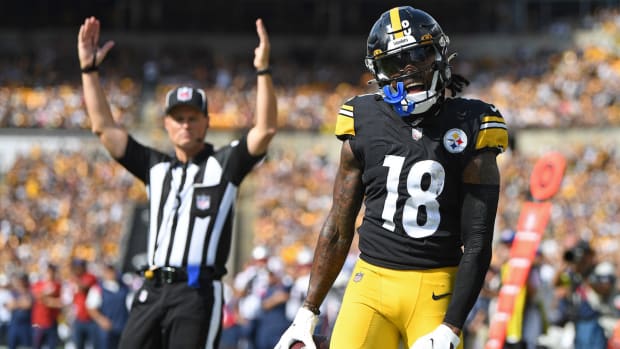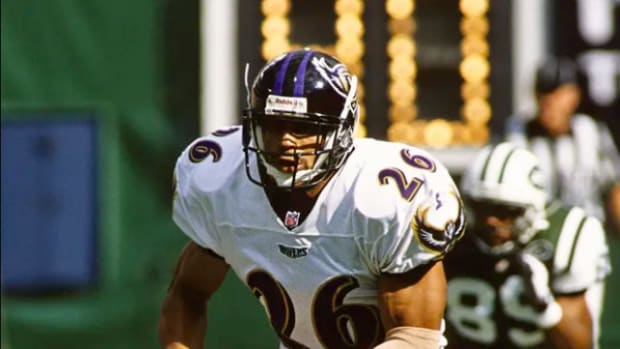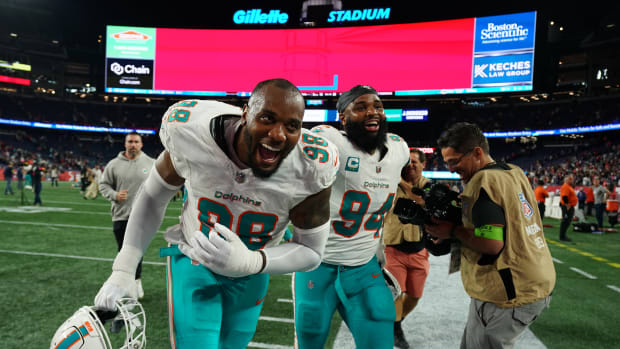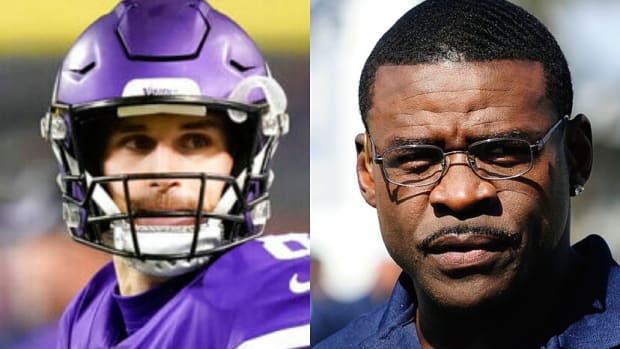Broncos and Ravens Get a Major Piece of Offseason Business Done Early with Joe Flacco Trade
The Broncos’ agreement to trade for Joe Flacco on Wednesday did several things. It highlighted Denver’s swings and misses in trying to find Peyton Manning’s replacement at quarterback—Paxton Lynch, Case Keenum, et al. It showed urgency to win, with defensive guys Von Miller, Brandon Marshall and Chris Harris all turning 30 between now and September. It opened a window into how the new coaching staff wants to build. And, believe it or not, it gave the team long-term flexibility.
I’m not here to pave over the broken road that John Elway and Co. took to get here. But given the present circumstances? I don’t hate the trade.
Think of it like this: you’re looking to buy a house long-term and you’re on a flexible month-to-month lease in your current living situation. If you’re renting on a set yearly lease, you might feel antsy or take a counteroffer you shouldn’t, knowing there’s a real deadline coming—in essence allowing your short-term situation to creep into your long-term decision-making. But on a month-to-month lease, you can be patient. You’re operating from a position of strength.
Flacco is, in this case, the month-to-month lease, whereas Keenum became the set lease as he and the Broncos went into the final year of the pact they struck last March. Flacco has three years left on the contract Denver is inheriting, at $18.5 million for 2019, $20.25 million for ’20, and $24.25 million for ’21. None of that is guaranteed. All of it is in the form of base salary. The Broncos can move on whenever.
Denver gets a quarterback that it believes in now, sending their 2019 fourth-round pick to Baltimore in return, but that doesn’t preclude the franchise from drafting one with its first-round pick—like the Browns did after trading for Tyrod Taylor, the Jets did after signing Josh McCown and Teddy Bridgewater, and the Cardinals did after inking Sam Bradford last year. And if the Broncos don’t love the class? Or they can’t get their guy? Then they can wait, leaning on Flacco.
ORR: What the Joe Flacco Trade Means for the Broncos, the Ravens, Nick Foles and the 2019 NFL Draft
This isn’t some kind of grand-slam move for Elway. Everyone knows how he got here, and we don’t know how Flacco will play in Denver, especially given that he’s a big man with recent history of back and hip problems.
What I do know is how you wind up with Christian Ponder or EJ Manuel or, yup, Lynch. In a lot of cases, it’s been because a team has no answer at quarterback, and predetermines that it’ll draft one in the first round. If the right guy’s not there? Then you talk yourself into one, like you might that counteroffer.
At the very least Denver won’t be tempted to do that. If healthy, and based on how he played before he got hurt last year, Flacco’s a fine short-term quarterback for the Broncos. The team can win with him, and maybe more than that. And just as important, he’ll allow you to be judicious with Elway’s long-term plan.
In this week’s GamePlan, we’re going to answer your questions on the Giants and Cardinals quarterback situations, which quarterbacks could follow the Kirk Cousins Get Rich Plan, what coordinators make in the NFL, how the CBA could change before its 2021 expiration and more.
But this has been a big news week, and there’s no bigger story this week than a Super Bowl-winning quarterback changing teams, even if we knew Flacco’s time as a Raven was finished after head coach John Harbaugh handed the reins to Lamar Jackson, who led Baltimore’s late-season surge.
I know this is easy to say in the immediate aftermath, but I think the deal is a good one for both sides. The Ravens get a major piece of business done early, give a player who’ll be in their Ring of Honor a graceful and timely exit and move forward with certainty (knowing they’ll have to eat $16 million in dead money).
From the Broncos’ perspective, there’s the aforementioned flexibility, and the chance to play both for today and tomorrow at quarterback. And here are some important facts in that regard …
• The $63 million over three years left on Flacco’s deal puts his Broncos’ APY at $21 million. That ranks No. 12 in the NFL for 2019, between Ben Roethlisberger and Eli Manning. His cap hit of $18.5 million ranks No. 21. So $63 million over three years may sound like a lot. It’s not.
• Flacco had arguably his best, most consistent year as a pro under Gary Kubiak in 2014. Rich Scangarello, his new coordinator in Denver, cut his NFL teeth under Kyle Shanahan, who came up under Kubiak. Some of what made Flacco successful five years ago should come back to him now, which is a piece of what the Broncos saw here.
• Kubiak was a factor in the Broncos’ quarterback planning before he left the organization a month ago, so it’s fair to say that he provided good insight into Flacco. And new coach Vic Fangio not only was with Flacco for two years in Baltimore, but also maintained relationships with defensive coaches there, which helped in vetting the QB leading up to the trade agreement.
• The Demaryius Thomas trade helped set the stage for this. The pick going to Baltimore is Denver’s slotted fourth rounder, which the Broncos are O.K. giving up because the team gained a fourth rounder from Houston in the Thomas deal. That one is 12 slots lower than Denver’s original pick. For the Broncos, this amounts to taking on the money, and dealing Thomas for Flacco, while moving a pick in the low 100s down a dozen spots.
And again, I don’t know if this works out for both sides or not. But it’s not hard to see why the Broncos did it.
BENOIT: Why the Broncos Are Banking on Joe Flacco’s Return to Form
As for the other quarterbacks on the market …
I don’t think the Flacco trade affects the veteran market much. The Broncos weren’t seen necessarily as an open seat at the quarterbacking table a month ago, and so you’re not really taking a seat away, but you are taking a starting quarterback out of the mix without really introducing a new one to market. And while Denver will shop Keenum, it’s hard to believe anyone will bite with his 2019 base at $18 million or, after he’s released, entrench him as a starter elsewhere.
In that way, this actually could be good for Nick Foles and Bridgewater, in regards to potential openings for jobs in Jacksonville, Miami and Washington.
Bridgewater could represent a win/win for the Redskins—where the player gets a chance to reestablish himself as an NFL starter, and the team gets a very solid for-now starter with so much uncertainty swirling around Alex Smith.
As for Foles, his situation is more complicated. The Eagles have until March 5 to decide on hitting him with the franchise tag. That gives them three weeks to find a suitor willing to deal for him with the $25 million (or so) tag attached, find out whether Foles is willing to go to and/or explore a long-term deal with that team, and do it without breaking the rules on the tag that say it’s not there to facilitate trades.
Eagles czar Howie Roseman is great at this kind of thing, of course. But this one won’t be easy, particularly when Foles may be motivated to see whether the division rival Giants (with his old OC Pat Shurmur) or Redskins would be interested.
Maybe a deal with someone like Jacksonville, and another old OC of Foles’s (John DeFilippo), gets done. Maybe the Eagles decide just to let Foles walk and collect the 2020 comp pick (which would probably be a third-rounder) instead.
BENOIT: Ranking the NFL’s Neediest Teams Heading into Free Agency and the Draft
That’s the story on the guys throwing the ball. Now for those catching it …
Antonio Brown put out the 2019 equivalent of a bat signal on Tuesday, tweeting, “Thank you Steeler Nation for a big 9 years…time to move on and move forward” with a peace-sign emoji and “New Demands” hashtag. So what does it all mean? Here’s what I know about that situation …
• Brown has not talked to any member of the Steelers brass—including head coach Mike Tomlin, GM Kevin Colbert and owner Art Rooney—since the season ended, according to sources. His agent, Drew Rosenhaus, has been in contact with the team.
• The aforementioned tweet was not the result of any single event. Some in the Steelers organization, in fact, theorized it may have stemmed from the NFL news cycle spinning fast at the beginning of this week—and Brown not wanting his situation to be lost in the shuffle. “He’s not a bad guy, but he craves attention and credit,” said one source.
• The Steelers, as I understand it, are against trading him in the division, and against trading him to the Patriots. They’ll listen to offers from the other 27 teams.
• Is it a 100% guarantee that he gets dealt? No. Pittsburgh’s roster is aging in key spots, at quarterback, along the offensive line and in spots on defense, and there is some feeling that making it work short-term with Brown might make the most sense, given the circumstances. That, of course, would require Brown’s cooperation and a lot of fence-mending.
• It’d cost them the $2.5 million roster bonus due to hold on to him past March 17. If they were willing to do that, then the idea of trying to make it work and revisiting at the trade deadline in October could come into play.
• All of this said, I’m told Brown’s camp has put in multiple trade requests with the Steelers over the last two months.
• Brown’s contract as presently constituted represents great value—he’s due $39 million over the next three years, none of it guaranteed. That APY of $13 million is what Philadelphia’s Alshon Jeffrey and Indianapolis’ T.Y. Hilton make. But other teams have expressed a belief that if they were to do a deal for Brown, he’d ask for a contract adjustment.
• For one reason or another, receivers have fetched a big return on the market historically. Oakland got a first-round pick for Amari Cooper in October. Brandin Cooks was traded for first-rounders in consecutive offseasons. And the Steelers are most assuredly looking at comps here.
We’ll see where this goes. If the Steelers wind up dealing him, the Raiders would be one interesting team to watch—Jon Gruden has said they need a No. 1 receiver, and has an affinity for veteran players, plus three first-round picks and a lot of cap space burning holes in his pockets. And I’d imagine, if Brown’s willing to play on his current deal, there’d be more than a couple teams interested.
VRENTAS: Kareem Hunt Could Have Earned His Way Back into the NFL—But Not This Quickly
While we’re there, Brown wasn’t the only receiver making waves this week …
Fox Sports’ Jay Glazer caught the attention of plenty in his mailbag on The Athletic this week, predicting an Odell Beckham trade in answering a question. Glazer doesn’t pull things out of thin air, and Beckham added to the intrigue with a cryptic tweet a few hours later that pushed silence and happiness (I think).
A Beckham trade is not impossible here. My belief is the Giants came to grips with the fact that they’re in rebuild—not a retool—last year. It’ll take patience. That makes it fair to ask if Beckham is worth more to them as an asset than he is as a player right now. And as an asset he’s a true No. 1, signed for the next five years at $77 million (a reasonable $15.4 million per) with $19.5 million left guaranteed.
I doubt the Giants actively shop him now, but there’s a larger piece to this—this isn’t a great receiver draft, and the free-agent class (Golden Tate, Adam Humphries, Cole Beasley, Jamison Crowder, Randall Cobb, etc.) isn’t off the charts, either. So my expectation is aggressive teams that need big-time receivers are going to get creative.
That means asking about true No. 1s, like Julio Jones (who wants a new contract), A.J. Green (who has a new coach), and Beckham. That doesn’t mean those guys are close to as likely to be dealt as Brown is. But I think those teams will be getting calls on those players, because I’ve been asked about those players’ availability over the last few weeks. Alright, finally, we get to your mail …
MAIL TIME
From Mike (@mspielNYMNYG): Giants Quarterback situation, what’s the plan for Eli and potential successor?
I think we can relate this back to how I explained the Flacco situation—Manning’s contract is no longer at, or even close to, the top of the market for his position. The Giants have him at $17 million for this year. That’s right around half the average-per-year that Aaron Rodgers is getting in Green Bay, and it’s less than Keenum made to be the quarterback in Denver last year.
Presuming they don’t get a blockbuster offer, and Manning’s amenable to being a good soldier should his successor arrive in April (or before then), it makes all the sense in the world to go forward with him in his contract year. You’ll get a motivated player, and someone who’s respected in the locker room. And you won’t be guessing on how some bridge quarterback might fit.
Maybe they do pursue someone like Foles. I believe the more likely outcome here is Manning sticking around in 2019 with a rookie behind him.
And of course, it goes without saying the Giants are looking seriously at taking a quarterback with the sixth pick in the draft, and maybe trading up for one. They have, in fact, already done a bunch of homework—GM Dave Gettleman and assistant GM Kevin Abrams live scouted a number of the top quarterbacks in the fall (They saw Oregon’s Justin Herbert, who stayed in school, and Murray in November.)
NFL DRAFT BIG BOARD: The Pre-Combine Top 50
From Sam Tibolt (@samtibolt): What will Marcus Mariota's future be if he stays healthy next year and leads the Titans to the playoffs?
Probably the franchise tag. And it raises an interesting question going into 2019—Could there be a quarterback setting up to go down the Kirk Cousins path? Cousins parlayed his team’s uncertainty on his future into two franchise tags, then unrestricted free agency last March, which led to the only fully guaranteed multi-year deal in NFL history.
There are three guys who could be positioned to do the same starting a year from now. Mariota is one. Tampa Bay’s Jameis Winston is another. And Dallas’ Dak Prescott would be the third. All three will need to play well, but each could reach the end of a rookie deal, with a franchise tag between $25 million and $30 milion waiting for them in 2020.
JONES: The Offseason Quarterback Moves Each NFL Team Should Consider (If Any)
From René Bugner (@RNBWCV): Why don´t teams invest more money in long-term contracts for good offensive/defensive coordinators?
Rene, they actually do! Did some digging on the actual numbers, and with a little help from some coaching agents, I was able to come up with a few interesting facts on what coordinators make. So here you go …
• Every defensive coordinator in the NFL and almost every offensive coordinator makes seven figures. So the baseline is a million per.
• Offensive coordinators make less than defensive coordinators. Why? Because there are 20 head coaches with offensive background, and just 12 with defensive background. That makes defensive assistants more valuable. The mean and median for defensive coordinators is between $1.65 million and $1.8 million, I’m told. For OCs, it’s between $1.5 million and $1.6 million.
• The top of the market on both sides of the ball is around $3 million per. A select few make over $3 million per.
So that should tell you teams are investing in coordinators. If you’re saying they should do more to keep guys long-term, I’d tell you that you can’t really stop guys from becoming head coaches and, if a guy wants to leave, all he has to do is refuse an extension and wait his deal out. In that way, the NFL’s like any business. If you have great people, you’ll eventually get to the point where it’s tough to keep them.
If you want the latest episode of The Monday Morning NFL Podcast in your feed when you wake up Monday morning, then subscribe to The MMQB Podcasts. For non-subscribers, there is typically a soul-crushing lag.
From John West (@westy154): What’s the legacy of Super Bowl 53? Belichick’s master planning, or Rams crapping the bed? How will history ultimately remember it?
I really think it’s one of Belichick’s finest moments. The 2018 Patriots were made up of players in his image, and the emergence of a Patriots defense as a dominant unit (after some very tough moments during the regular season) was football’s version of chess at its highest level.
And that’s a huge credit to the players too. Some of those guys would get offended by the idea talent was an issue. Truth is, at times, talent was an issue, but only because Belichick was willing to give on talent in building the roster to get versatility and intelligence. The final result, which I didn’t see coming, was a smart, malleable group that unlocked all of Belichick’s ability as a coach.
On offense I think these Patriots—Tom Brady and Rob Gronkowski and Julian Edelman—were the proud old prizefighters (I’ve used that analogy with them a lot) who kept swinging and when they got to the 12th round, somehow they were throwing more heat than anyone else.
It really was an amazing season for the New England dynasty in a lot of ways, and what happened shouldn’t be used to take anything away from the Rams, who still have an incredibly bright future.
BISHOP AND BASKIN: How the Patriots Built Football’s Greatest Dynasty
From Mike Jennings (@SavageDad84): Will Kliff Kingsbury draft Kyler Murray and ultimately trade Josh Rosen?
I don’t think so, Mike. But I wouldn’t totally rule anything out—anyone trying to peg Kingsbury’s type at that position is wasting their time. His strength as a college coach was working with different kinds of quarterbacks, from Keenum at Houston to Johnny Manziel at A&M to Baker Mayfield, Davis Webb and Patrick Mahomes at Tech. He can fit his offense to different kinds of guys.
What I can say is that there was some concern over how Rosen’s rookie year went, and I’m not sure everyone in the building was totally sold on him coming out of that. But it’s Kingbury’s show now. He’s watched Rosen’s tape. He said that Rosen “is our guy.” I’ll take that at face value—even though I know it’s what he has to say—until I hear otherwise.
From René Bugner (@RNBWCV): Is the whole CBA set in stone for the whole length? IIRC everyone agrees that the current rules for offseason contact between players & coaches and length of OTAs makes the NFL a bad product in September/October, why can´t they change it?
Just because I like you, Rene, and you’ve kept the questions coming, I’ll answer two for you this week. No, the CBA isn’t set in stone for the whole length of the deal. The league and union can always make adjustments. But that’s the thing—over the last decade, those two parties haven’t been able to agree on the color of the sky, so it’s never going to be easy to amend what they agreed to in 2011.
Why won’t they change the offseason rules? That was a win for the players in 2011, and the owners, in the end, have other things that are far higher on their list of priorities (see: anything involving money). The group that’s most passionate about change in this regard is one that doesn’t have a seat at the table, although, as we wrote in March 2017, the coaches have organized to make their voice heard on it.
From William Hronis (@WHronis): Will we see a lot of draft trades in 2019?
William, I’d tell you that while I think teams will be aggressive on the trade market in general, as I said earlier, this year’s draft class doesn’t lend itself to a ton of trading at the top. The quarterback class isn’t as good as last year’s, and probably isn’t as good as next year’s. And one thing you hear about the class in general is there might not be much difference between the fifth and No. 25 picks this year.
What could change things? The quarterbacks could get hot, like Jared Goff and Carson Wentz did in 2016, which was also presumed to be a mediocre year at the position early on. Or there could be runs on positions to seep the supply, juices the demand, and pressure teams into dealing up.
But right now, in mid-February, it looks like the kind of year where it’ll be tough for teams in the Top 10 to trade down.
Question or comment? Email us at talkback@themmqb.com.




































